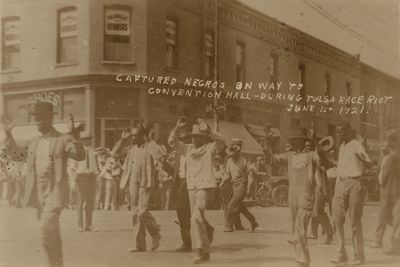
The low, moaning sound of a cello catches my ear as the doors to First Baptist Church of Tulsa’s Race Massacre Prayer Room open. On the walls hang historical memorabilia —black-and-white photographs, newspaper editorials, quotations from survivors, Red Cross buttons faded from time and wear. All date back to May and June one hundred years ago when the worst civil rights disaster since the Civil War took place.
The 1921 Tulsa Race Massacre.
‘Massacre’ is the word we use today to describe the events that unfolded when white men took up arms and marched down Black Wall Street, a prominent stretch of affluent black-owned businesses and establishments in downtown Tulsa. They rushed forward in mobs under the guise of avenging an unproven young white woman’s claim of assault. The rumblings of racial animosity, vehemence, even economic jealousy, however, had long been the driving force behind what took place on that warm night of May 31st. A single spark was all it took. One proverbial match. And the entire Greenwood District — thirty-five square blocks in all — was set ablaze.
I stand and stare at the photographs that hang on these cream-colored walls. They depict a destruction rarely mentioned in high school textbooks. One photo shows smoke billowing up from atop three-story buildings. Another shows Mt. Zion Baptist Church (or what was left of it) as despairing faces sift through its smoldering rubble. Twelve churches were burned that day. So were five hotels, four drug stores, eight doctors’ offices, thirty-one restaurants, and one public library.
Even worse, no one really knows the number of black people who died. Best guess? Probably three hundred, according to information provided by the Tulsa Historical Society and Museum. What we do know is several hundred men, women, and children limped or were carried into makeshift Red Cross tents. Gunshot wounds, burns, even miscarriages brought them in. The cello plays again its lonely dirge.
Have we learned anything yet?
Out of my periphery, I see an editorial hanging on the opposite wall from me. The graininess of its oversized reproduction makes its words appear distorted, inflammatory yet still legible. The title reads, “It Must Not Be Again.” Here is the start of a worthy prayer, I think. But quickly I realize this editorial is not fodder for spiritual petitioning ...

